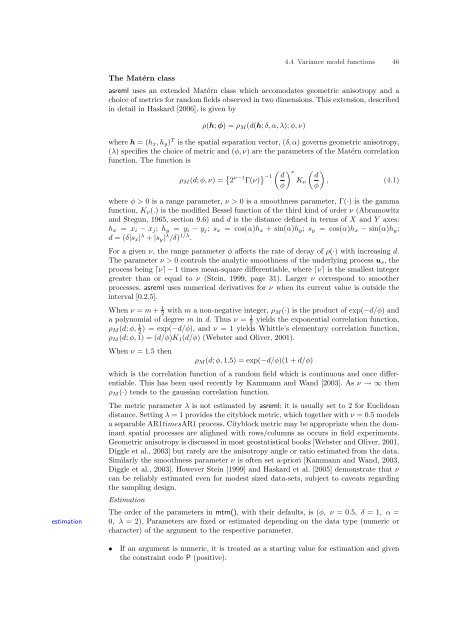ASReml-S reference manual - VSN International
ASReml-S reference manual - VSN International
ASReml-S reference manual - VSN International
- No tags were found...
Create successful ePaper yourself
Turn your PDF publications into a flip-book with our unique Google optimized e-Paper software.
The Matérn class4.4 Variance model functions 46asreml uses an extended Matérn class which accomodates geometric anisotropy and achoice of metrics for random fields observed in two dimensions. This extension, describedin detail in Haskard [2006], is given byρ(h; φ) = ρ M (d(h; δ, α, λ); φ, ν)where h = (h x , h y ) T is the spatial separation vector, (δ, α) governs geometric anisotropy,(λ) specifies the choice of metric and (φ, ν) are the parameters of the Matérn correlationfunction. The function isρ M (d; φ, ν) = { 2 ν−1 Γ(ν) } ( ) ν (−1 d dK ν , (4.1)φ φ)estimationwhere φ > 0 is a range parameter, ν > 0 is a smoothness parameter, Γ(·) is the gammafunction, K ν (.) is the modified Bessel function of the third kind of order ν (Abramowitzand Stegun, 1965, section 9.6) and d is the distance defined in terms of X and Y axes:h x = x i − x j ; h y = y i − y j ; s x = cos(α)h x + sin(α)h y ; s y = cos(α)h x − sin(α)h y ;d = (δ|s x | λ + |s y | λ /δ) 1/λ .For a given ν, the range parameter φ affects the rate of decay of ρ(·) with increasing d.The parameter ν > 0 controls the analytic smoothness of the underlying process u s , theprocess being ⌈ν⌉ − 1 times mean-square differentiable, where ⌈ν⌉ is the smallest integergreater than or equal to ν (Stein, 1999, page 31). Larger ν correspond to smootherprocesses. asreml uses numerical derivatives for ν when its current value is outside theinterval [0.2,5].When ν = m + 1 2 with m a non-negative integer, ρ M (·) is the product of exp(−d/φ) anda polynomial of degree m in d. Thus ν = 1 2yields the exponential correlation function,ρ M (d; φ, 1 2) = exp(−d/φ), and ν = 1 yields Whittle’s elementary correlation function,ρ M (d; φ, 1) = (d/φ)K 1 (d/φ) (Webster and Oliver, 2001).When ν = 1.5 thenρ M (d; φ, 1.5) = exp(−d/φ)(1 + d/φ)which is the correlation function of a random field which is continuous and once differentiable.This has been used recently by Kammann and Wand [2003]. As ν → ∞ thenρ M (·) tends to the gaussian correlation function.The metric parameter λ is not estimated by asreml; it is usually set to 2 for Euclideandistance. Setting λ = 1 provides the cityblock metric, which together with ν = 0.5 modelsa separable AR1timesAR1 process. Cityblock metric may be appropriate when the dominantspatial processes are alighned with rows/columns as occurs in field experiments.Geometric anisotropy is discussed in most geostatistical books [Webster and Oliver, 2001,Diggle et al., 2003] but rarely are the anisotropy angle or ratio estimated from the data.Similarly the smoothness parameter ν is often set a-priori [Kammann and Wand, 2003,Diggle et al., 2003]. However Stein [1999] and Haskard et al. [2005] demonstrate that νcan be reliably estimated even for modest sized data-sets, subject to caveats regardingthe sampling design.EstimationThe order of the parameters in mtrn(), with their defaults, is (φ, ν = 0.5, δ = 1, α =0, λ = 2). Parameters are fixed or estimated depending on the data type (numeric orcharacter) of the argument to the respective parameter.• If an argument is numeric, it is treated as a starting value for estimation and giventhe constraint code P (positive).
















